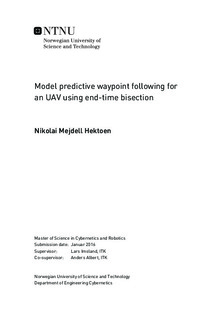Model predictive waypoint following for an UAV using end-time bisection
Master thesis
Permanent lenke
http://hdl.handle.net/11250/2382512Utgivelsesdato
2016Metadata
Vis full innførselSamlinger
Sammendrag
Ice surveillance is motivated by a need to improve the safty for shipping and offshore industries in the arctic waters. This thesis describes the implementation and simulation results for a model predictive controller (MPC) for a iceberg surveillance by UAV, using an end-time-based optimization scheme. The optimization scheme uses a bisection method to find the end-time over a series of smaller optimizations. This method was an improved version of a method devised in project work during the spring of 2015. The implementation of the MPC scheme and optimization algorithm is done in Python, using the sybolic framework Casadi.
The model predictive controller performed well if the wind distubance on the UAV was known, since the wind could be coupled foreward by the optimal controller. It was found that the UAV could handle wind disturbances of more than half its own speed. However, in cases were parts of the wind disturbance was unknown, the simulated UAV would be blown off course since there was no integral effect in the control loop. The performance of the bisection method used on the end-time in the optimal controller found good solutions as long as the vehicle was some distance away from the target waypoints.
Baring these two problems, the whole control system performed quite well. And with additions such as an wind estimator and a backup controller, which addresses these problems, the overall performance would be even better.
